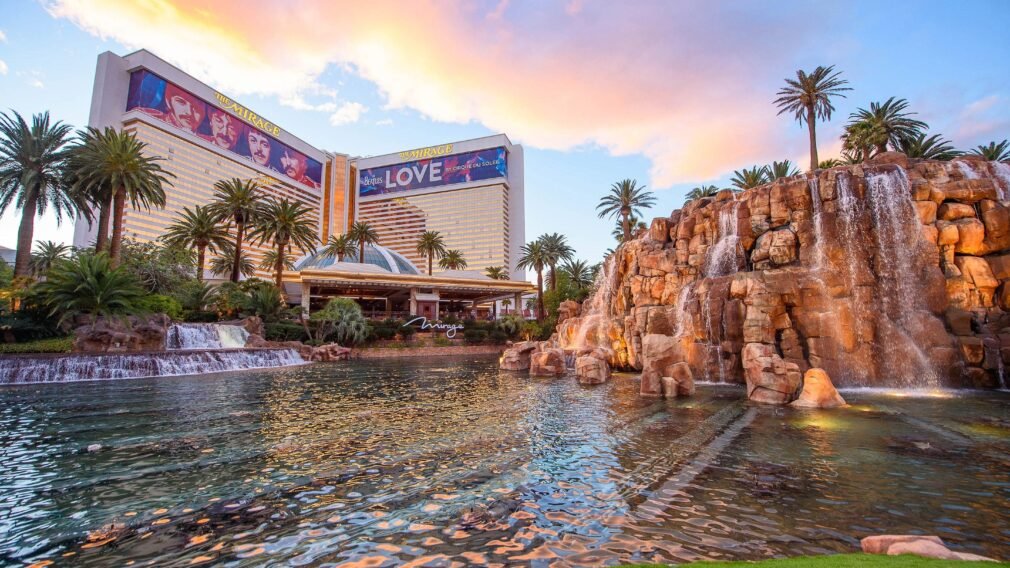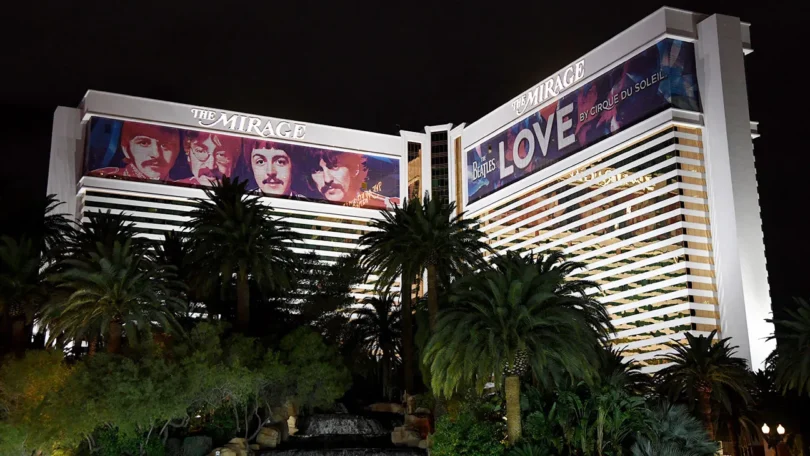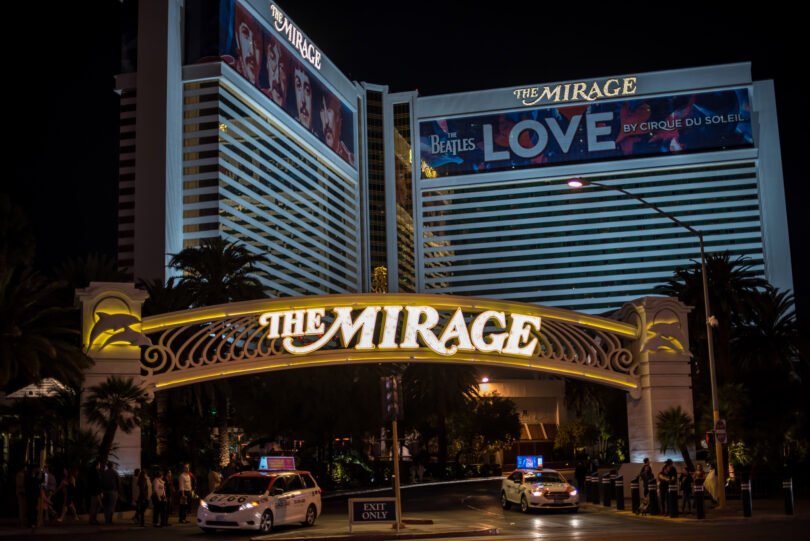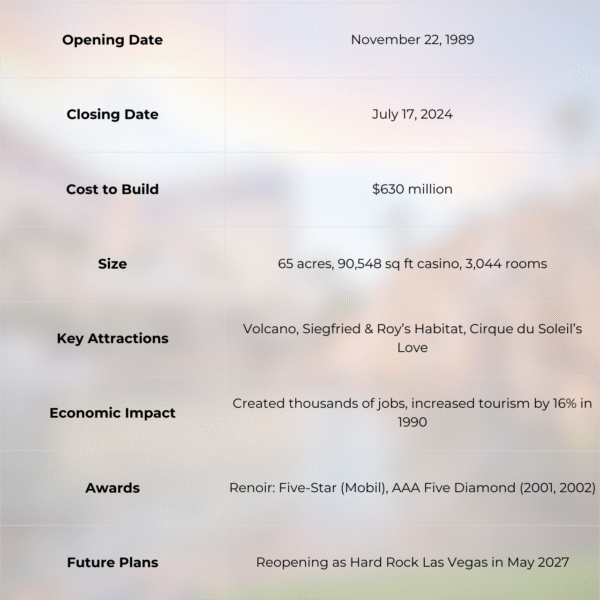Mirage Casino: A Las Vegas Classic
The Mirage, a trailblazing icon on the Las Vegas Strip, redefined luxury and entertainment when it opened on November 22, 1989, with its Polynesian flair and a show-stopping volcano erupting nightly. As the Strip’s first megaresort, it set a new standard, blending innovative design, groundbreaking attractions, and world-class shows that reshaped Vegas’s identity. Closing its doors on July 17, 2024, after 34 years, The Mirage now paves the way for Hard Rock International’s Guitar Hotel, set to debut in May 2027, leaving a legacy that forever changed the world’s entertainment capital.

The Birth of a Megaresort
The Mirage was the brainchild of Steve Wynn, a visionary who reshaped Las Vegas after turning the Golden Nugget into a luxury hotspot. In October 1986, Wynn purchased land on the Strip, including the site of the old Castaways hotel-casino, which was demolished to make way for his ambitious project.
Construction began in November 1987, costing a staggering $630 million, the most expensive hotel-casino ever at the time, funded largely through $525 million in “junk bonds” from Drexel Burnham Lambert, a Wall Street financing first for Vegas, overseen by Wynn and Bobby Baldwin.
Opened on November 22, 1989, after Wynn fast-tracked the debut to host a Sugar Ray Leonard vs. Roberto Durán III boxing match, The Mirage drew 750,000 visitors in its opening weekend, overwhelming the Strip with crowds and a $4.6 million slot jackpot hours after launch.
As the first new resort on the Strip in over 15 years and its first megaresort, it sparked a 1990s building boom, proving Wynn’s vision of a resort as a destination, not just a casino, and cementing Las Vegas as a global entertainment hub.
Iconic Attractions
The Mirage redefined Las Vegas with groundbreaking attractions that made it a destination beyond gambling, embodying Steve Wynn’s vision of a resort as a spectacle. Key features included:
-
Volcano Eruption: A massive artificial volcano, designed by WET Design, erupted nightly with fire, lights, and music, drawing crowds with its free Strip-side show, enhanced by a piña colada scent to mask gas odors; upgraded in 2008 for $25 million, it was demolished post-closure.
-
Siegfried & Roy’s Shows and Habitats: The legendary duo’s magic acts with white tigers filled a 1,500-seat theater, complemented by the Secret Garden and Dolphin Habitat, showcasing exotic animals like snow leopards and elephants, with a free tiger-viewing glass wall; their $58 million show ended after a 2003 tiger incident, but their legacy lives on in Siegfried and Roy Drive.
-
Cirque du Soleil: The Mirage pioneered Vegas’s Cirque era with Nouvelle Expérience in 1992, followed by the Beatles-themed Love from 2006 to 2024 in a 2,000-seat theater, captivating 8 million viewers over a decade with cutting-edge sound.
-
Award-Winning Dining: Restaurants like Renoir, a Mobil Five-Star and AAA Five Diamond winner in 2001-2002, alongside Osteria Costa and Tom Colicchio’s Heritage Steak, elevated Vegas’s culinary scene, joined by casual spots like Carnegie Deli.
-
Tropical Ambiance: A 60-foot domed atrium with a rainforest, a $1.2 million aquarium behind the check-in desk, and a sprawling Polynesian-style pool area immersed guests in an exotic escape.
These innovations turned The Mirage into a multifaceted entertainment hub, setting a blueprint for luxury resorts and transforming Las Vegas into a global tourism magnet.

Transforming Las Vegas
The Mirage reshaped Las Vegas, ushering in a new era of grandeur and ambition for the Strip. Key impacts include:
Pioneering Megaresorts: Opened in 1989 as the Strip’s first megaresort and the costliest hotel-casino at $630 million, it ended a 15-year building drought, inspiring a 1990s construction boom with iconic resorts like Bellagio and Venetian emulating its innovative model.
Tourism Surge: Amid a tourism dip sparked by Atlantic City’s gambling legalization, The Mirage’s debut fueled a 16% visitor spike in 1990—one of the city’s largest annual jumps, revitalizing Las Vegas as a must-visit destination.
Redefining the Vegas Experience: Steve Wynn’s vision made The Mirage a standalone attraction, less reliant on gambling, with its volcano, animal habitats, and top-tier dining shifting the city’s image from a gaming hub to a luxurious, family-friendly entertainment capital, drawing a broader audience.
By blending high-end hospitality, diverse entertainment, and a holistic resort experience, The Mirage set a new standard, fundamentally rebranding Las Vegas as a global tourism and culinary powerhouse.

Cultural Legacy
The Mirage left an enduring mark on popular culture and Las Vegas’s identity, becoming a symbol of the city’s dazzling allure. Key cultural impacts include:
-
Pop Culture Icon: Featured in films like Ocean’s Eleven (2001), where it was one of three casinos robbed, and Vegas Vacation (1997), showcasing its pool and Siegfried & Roy show, The Mirage also appeared in Pure Country(1992), Sgt. Bilko (1996), and TV finales like The Amazing Race (2009, 2014), while inspiring The Killers’ 2020 album Imploding the Mirage and the Grand Theft Auto: San Andreas resort “The Visage.”
-
Community Engagement: The Mirage connected with locals by involving Vegas Verde Elementary School fourth-graders in naming efforts, adding a heartfelt community touch to its legacy.
-
Accolades and Influence: Its dining, led by Renoir’s Mobil Five-Star and AAA Five Diamond awards (2001-2002), elevated Vegas’s culinary reputation, while critically acclaimed shows like Siegfried & Roy’s magic acts and Cirque du Soleil’s Love earned widespread praise, with Siegfried and Roy Drive named in 2020 to honor the duo’s impact.
Through its vibrant media presence, local ties, and award-winning innovations, The Mirage cemented its status as a cultural cornerstone, forever shaping Las Vegas’s image as a global entertainment beacon.
Closure and Future
The Mirage bid farewell on July 17, 2024, after 34 years, with its hotel closing July 15 and gaming operations halting early that final day, marking the end of an era. Emotional ceremonies featured speeches by former mayor Jan Jones Blackhurst and Elaine Wynn, who called the moment “poignant,” noting Las Vegas’s cycle of reinvention, capped by the volcano’s final eruption, a bittersweet spectacle for fans.
The closure impacted 3,000 workers, with Hard Rock International, which acquired The Mirage for $1.08 billion in 2022, providing $80 million in severance, including $2,000 per year of service for 1,700 unionized staff, alongside benefits; 137 “Day One” employees from 1989 embraced new chapters.
Now, Hard Rock plans a dramatic transformation into the Hard Rock Hotel & Casino and Guitar Hotel Las Vegas, featuring a 660-foot guitar-shaped tower replacing the volcano, 596 new rooms for a total of 3,640, and a May 2027 opening, employing up to 6,000. Artifacts like the Siegfried & Roy statue and signage will live on at The Neon Museum, preserving The Mirage’s legacy as Las Vegas evolves.

Conclusion
The Mirage, from its dazzling debut on November 22, 1989, to its closure on July 17, 2024, stands as a transformative force that redefined Las Vegas. Steve Wynn’s $630 million megaresort, the Strip’s first, ignited a 1990s building boom, inspiring giants like Bellagio and Venetian with its all-in-one model of luxury, entertainment, and dining. Its iconic volcano, Siegfried & Roy shows, and Cirque du Soleil spectacles shifted Vegas’s image from a gambling den to a family-friendly, world-class destination, boosting tourism by 16% in 1990.
Despite its closure, with Hard Rock International reimagining it as a guitar-shaped hotel by May 2027, The Mirage’s legacy endures, preserved in The Neon Museum’s artifacts and echoed in every modern resort. As Elaine Wynn noted, Las Vegas thrives by reinventing itself, and The Mirage’s pioneering spirit remains a cornerstone of the city’s evolution, forever etched in its vibrant history.
Recommended
